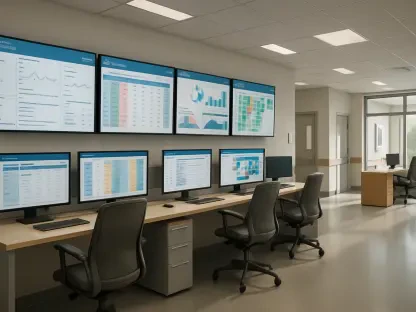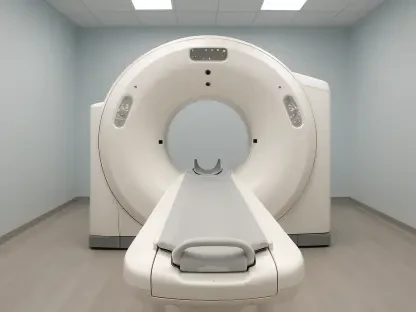In an era where heart disease remains a leading cause of mortality, claiming millions of lives annually across the globe, the demand for precise and innovative diagnostic tools has never been more critical. Imagine a technology capable of not only detecting plaque buildup in coronary arteries with unprecedented accuracy but also transforming how clinicians tailor treatments for patients. HeartFlow, a trailblazer in cardiovascular diagnostics, has recently secured FDA 510(k) clearance for an updated AI-driven plaque analysis platform, marking a pivotal moment in the industry. This development promises to reshape the landscape of heart disease management by offering enhanced insights into coronary health. This analysis delves into the market trends, data, and projections surrounding HeartFlow’s breakthrough, exploring its potential to drive growth in a sector hungry for precision medicine solutions.
Unpacking Market Trends and Technological Advancements
A Leap in Plaque Detection Capabilities
HeartFlow’s updated platform represents a significant technological advancement, boasting a 21% improvement in plaque detection compared to its earlier version cleared by the FDA a few years ago. Leveraging a robust dataset from 273,000 patients, the algorithm provides detailed assessments of plaque type, volume, and distribution through a 3D color-coded visualization model. This capability equips clinicians with actionable insights, enabling more accurate diagnoses and personalized treatment plans. The market for such advanced diagnostics is expanding as healthcare providers increasingly prioritize tools that enhance decision-making precision, positioning HeartFlow as a key player in meeting this demand.
Clinical Value Driving Market Interest
The clinical implications of this technology further fuel its market relevance, as evidenced by registry studies linking its use to notable reductions in LDL cholesterol levels among patients—a critical marker for heart disease risk. Unlike traditional diagnostic methods, HeartFlow’s personalized 3D models offer a deeper understanding of how plaque affects blood flow, facilitating targeted interventions. This outcome-driven approach aligns with the broader industry shift toward value-based care, where measurable improvements in patient health outcomes are becoming a benchmark for technology adoption. As hospitals and clinics seek solutions that demonstrate tangible benefits, the appeal of such platforms continues to grow.
Insurance Coverage as a Catalyst for Adoption
A crucial trend shaping the market is the increasing acceptance by major insurers, with Cigna recently joining UnitedHealthcare in updating policies to cover HeartFlow’s plaque analysis tool. Additionally, EviCore’s updated cardiac imaging guidelines reflect a growing consensus on the technology’s clinical utility, easing access for patients across diverse demographics. This alignment between regulatory clearance and payer support signals a maturing market environment, where barriers to entry are gradually diminishing. However, challenges persist in educating providers about the cost-effectiveness of AI-driven diagnostics, as misconceptions could hinder broader uptake in certain segments of the healthcare system.
Market Projections and Growth Opportunities
Tapping into a Multi-Billion Dollar Opportunity
Looking at the numbers, the market potential for coronary CT angiograms (CCTAs) combined with plaque analysis is staggering, estimated at $1.7 billion and applicable to approximately 5.5 million patients. HeartFlow is strategically positioned to capture a significant share of this opportunity, especially with its recent capital infusion of over $364 million from an initial public offering. This financial backing underscores strong investor confidence in the company’s ability to scale operations and penetrate deeper into the cardiovascular diagnostics space. Projections suggest that sustained growth will hinge on expanding access through partnerships and demonstrating long-term cost savings to stakeholders.
Competitive Landscape and Strategic Positioning
The competitive landscape in cardiovascular diagnostics is intensifying, with AI integration becoming a cornerstone of innovation among medtech firms. HeartFlow’s edge lies in its first-mover advantage and continuous refinement of its algorithms, setting a high bar for competitors. However, market penetration remains a hurdle, as the plaque analysis tool currently contributes minimally to overall revenue compared to HeartFlow’s flagship FFRCT Analysis product. To maintain momentum, strategic alliances with healthcare providers and insurers will be essential, alongside efforts to streamline integration into existing clinical workflows. The next few years, from 2025 to 2027, are expected to see accelerated adoption if these barriers are addressed effectively.
Future Trends Shaping the Sector
Beyond immediate market dynamics, broader trends point to a future where AI-driven diagnostics redefine cardiovascular care. The convergence of computational power and expansive datasets is likely to further enhance diagnostic accuracy, potentially extending applications to other vascular conditions. Economic factors, such as rising healthcare costs, will push providers toward technologies that optimize resource allocation, favoring solutions like HeartFlow’s platform. Yet, regulatory and access disparities across regions could temper growth, necessitating policies that ensure equitable distribution of such innovations in the global market over the coming years.
Reflecting on Market Insights and Strategic Pathways
Looking back, the analysis of HeartFlow’s FDA clearance for its advanced plaque analysis platform revealed a transformative shift in the cardiovascular diagnostics market, underscored by a 21% improvement in detection accuracy and robust clinical outcomes like reduced LDL cholesterol levels. The substantial $1.7 billion market opportunity, coupled with growing insurer support from entities like Cigna and UnitedHealthcare, highlighted the commercial viability of this technology. For stakeholders, the path forward involves prioritizing clinician education to dispel cost-effectiveness myths and investing in seamless integration into medical practices. Strategic partnerships emerged as a vital step to amplify adoption rates, while medtech businesses were encouraged to explore scalable models that addressed regional disparities. Ultimately, the focus shifted to building a collaborative ecosystem that could sustain innovation and ensure that millions of patients benefited from cutting-edge diagnostic advancements.









